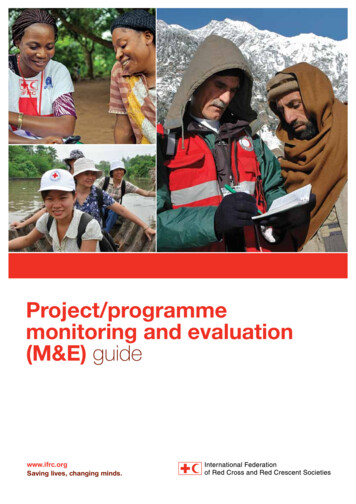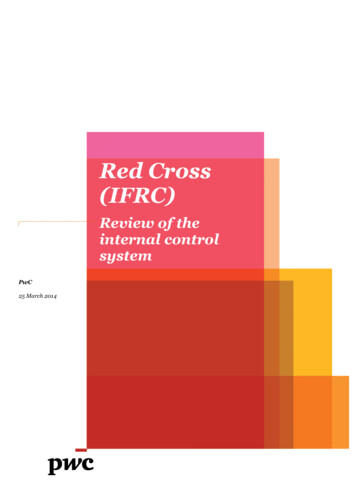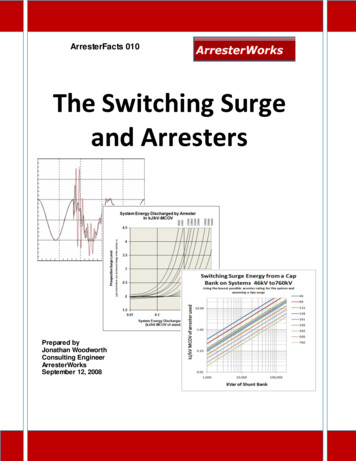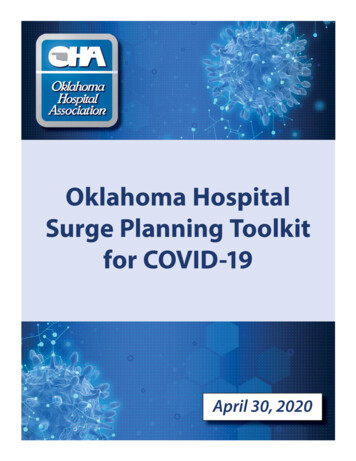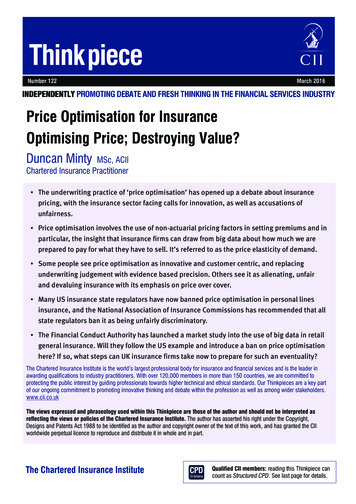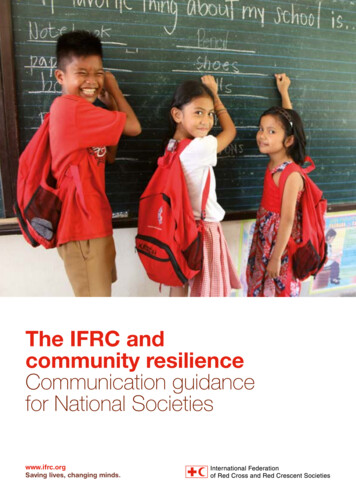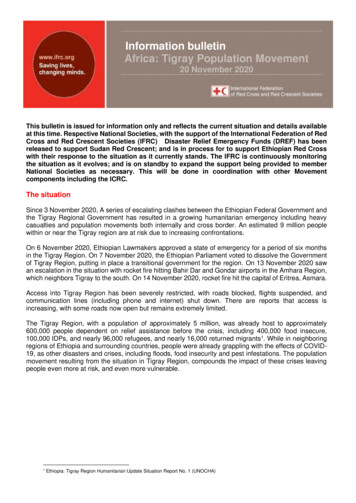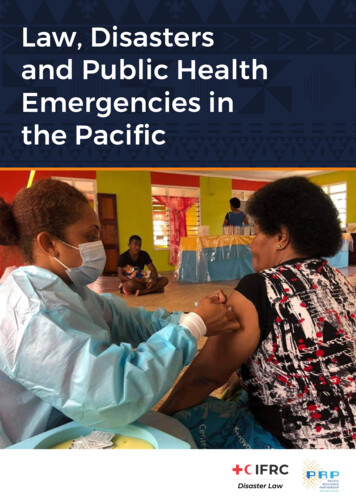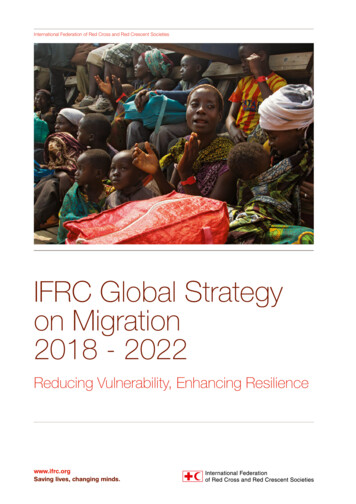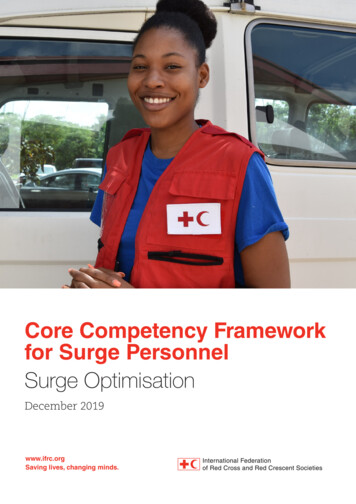
Transcription
Core Competency Frameworkfor Surge PersonnelSurge OptimisationDecember 2019www.ifrc.orgSaving lives, changing minds.
The International Federation of Red Cross and Red CrescentSocieties (IFRC) is the world’s largest humanitarian network,with 191 National Red Cross and Red Crescent Societies andaround 14 million volunteers. Our volunteers are presentin communities before, during and after a crisis or disaster.We work in the most hard to reach and complex settings inthe world, saving lives and promoting human dignity. Wesupport communities to become stronger and more resilientplaces where people can live safe and healthy lives, and haveopportunities to thrive. International Federation of Red Crossand Red Crescent Societies, Geneva, 2019Any part of this publication may be cited,copied, translated into other languages oradapted to meet local needs without priorpermission from the International Federationof Red Cross and Red Crescent Societies,provided that the source is clearly stated.Requests for commercial reproductionshould be directed to the IFRC Secretariat atsecretariat@ifrc.orgAll photos used in this study are copyright ofthe IFRC unless otherwise indicated.Cover photo:Name Surname/IFRC17 Chemin des CrêtsCH-1209 Geneva, SwitzerlandTelephone: 41 22 730 4222Telefax: 41 22 730 4200E-mail: secretariat@ifrc.orgWeb site: www.ifrc.orgCore Competency Framework for SurgePersonnelFollow us:
International Federation of Red Cross and Red Crescent SocietiesCore Competency Framework for Surge Personnel Surge OptimisationNovember 2019Jagan Chapagain,Under Secretary GeneralProgramme and Operations3
International Federation of Red Cross and Red Crescent SocietiesCore Competency Framework for Surge Personnel Surge OptimisationNovember 2019Surge PrinciplesSurge Optimisation is striving for operational excellence in crisis and disaster response througha joint effort, embedded in the Movement’s framework and the broader humanitarian environment. Itharmonizes current regional and global tools. It is guided by overarching Surge Principles:1. The Surge mechanism is part of a wider response system. It is accountable, fit for purpose, able todeploy the right people and services to the right place at the right time, as local as possible, asglobal as necessary.2. Staff and volunteers have equal access to joining Surge networks. Members of Surge networks haveequal access to deployment based on competences and availability. There are equitable opportunitiesfor progression within the Surge mechanism, based on merit.3. Roles, responsibilities and procedures are clear, transparent, known, held in common and adheredto.4. The Surge mechanism contributes to capacity building and support existing disaster preparednessinitiatives.5. Stakeholders commit to working together towards operational excellence where not achieved. TheSurge mechanism will monitor quality, learn and optimise.5
International Federation of Red Cross and Red Crescent SocietiesCore Competency Framework for Surge Personnel Surge OptimisationNovember 2019BackgroundThe multilateral nature of the Surge Response System – people from all parts of the Red Cross RedCrescent Movement working together to respond to emergencies – means that there is a need fora consistent framework for recruitment, development and performance management of surge personnel,to guarantee that the right people are deployed to the right place and at the right time.The absence of a consistent approach has led to a number of challenges: Inconsistency of surge personnel profiles deployed in similar roles Difficulty for National Societies to populate and maintain their surge rosters Challenging evaluation of surge personnel performance by surge team leaders Inconsistent tracking of surge personnel performance Overlapping and unfocused training/development strategies for surge rosters’ members across NationalSocietiesIn order to address these challenges, a Core Competency Framework for Surge Personnel has been developedas the underlying tool to be used for a consistent and competency-based approach to recruitment, selection,performance management, and learning and development of surge personnel across the Red Cross RedCrescent Movement. The practical use of the Core Competency Framework is aimed at ensuring equal accessfor all surge personnel, based on a framework of implementing, coordinating and leadership competencies.The Core Competency Framework has been developed and agreed collaboratively with a wide range ofstakeholders within the Movement as part of the Surge Optimisation process – and has been derived fromlooking at the existing competency frameworks of the IFRC (particularly the IFRC Emergency Team LeaderCompetency Framework), as well as those of other National Societies, DFID humanitarian competencies andthe Start Network Core Humanitarian Competencies. It has taken lessons from all these frameworks but hasbeen developed specifically for Red Cross Red Crescent surge personnel.The Core Competency Framework will be used for everyone being deployed into a surge response and it setsout the behaviours, skills and knowledge required by all surge personnel at all levels of a response operationand applies equally to all surge personnel.7
XXX
International Federation of Red Cross and Red Crescent SocietiesCore Competency Framework for Surge Personnel Surge OptimisationNovember 2019The Core Competency Framework –Definitions and StructureWhat is a competency?A competency defines behavior, knowledge and skills; it describes how work is to be done. It differs fromobjectives, which indicate what must be done, and activities that need to be completed.Structure of the Core Competency FrameworkThe Core Competency Framework is structured as follows (explained in detail below):Foundational TierName ofcompetencyDefinition of eachcompetency(The ability to )Tier 1Tier 2Tier uralindicatorsBehaviouralindicators(What behaviours isthe person expectedto demonstrate?)(What behaviours isthe person expectedto demonstrate?)(What behaviours isthe person expectedto demonstrate?)(What behaviours isthe person expectedto demonstrate?)The Core CompetenciesThere are twenty competencies in the framework, and these can be grouped into four broad categories:1.2.3.4.Red Cross Red Crescent competenciesOperational competenciesCross-Cutting competenciesBehavioural competenciesAll twenty core competencies are applicable to every surge role, regardless of their position in the operation.However, each competency is divided into four different tiers and the tier required for each competency will bedifferent depending on the position. The Core Competency Framework covers a number of operational deliverycompetencies that are also technical, such as assessment, safety and security, and community engagementand accountability. This is because to operate effectively in a surge role, one requires an understanding ofevery aspect of operational delivery, regardless of one’s specialisation.Tier DefinitionsThere are four tiers of competency, each with a set of indicators, and each tier builds upon the indicators setout in the previous tier. In other words, the Tier 2 competencies assume that all the Tier 1 competencies havebeen met and Tier 3 assumes all of Tier 1 and Tier 2 have been met. The tier definitions are as follows: Foundational tier: Foundational knowledge needed to build a deployable level of competency in thisarea. Tier 1: Displays a practical understanding of effective day-to-day behaviours for this competency andable to function effectively as part of a Red Cross Red Crescent team.9
International Federation of Red Cross and Red Crescent SocietiesCore Competency Framework for Surge Personnel Surge OptimisationNovember 2019 Tier 2: Displays impact for this competency by providing advice and guidance to others within a definedscope. Translates strategic decision into sectoral direction. Tier 3: Models the behaviours and creates an environment which enables these behaviours to bedisplayed. Operates at a strategic, multi-sectoral level in a response of any magnitude.Shelter Cluster CoordinationThe Shelter Cluster leadership roles entail partnerships and relationships outside the Red Cross Red CrescentMovement. As such, when related to the Shelter Cluster roles, references to the National Society and/orthe Movement can alternatively or additionally be interpreted as referring to the Government and/or otherhumanitarian agencies in the context of the Shelter Cluster role. Equally, the Shelter Cluster function isprimarily a coordination function, not an operational one. Therefore, references to operations, operationalcapacity or strategies, Plan of Action and the like could at times be interpreted as referring to coordinationand Shelter Sector Strategy instead, in the conduct of IFRC Shelter Cluster responsibilities. Finally, referencesto integrated and multi-sectoral operations or Plan of Action must be understood as a Humanitarian SystemWide Shelter Sector Strategy that considers the relationships and interoperability with other sectors andareas of humanitarian response.Indicative roles for each tier:The tier levels required for each competency will be defined in the Role Profiles. The tier level required willdepend on the requirements of the specific role for example, a Hygiene Promoter is an implementing role witha specific technical focus, therefore most of the core competencies will be required at a Tier 1 level, howeverdue to the specificities of the role they may require Cultural Awareness and Community Engagement andAccountability at a Tier 2 level. There are no indicatives roles at the foundational tier as this tier refers tofoundational knowledge necessary to develop competencies in the specific domains.Tier 1Tier 2Tier 3INDICATIVEROLEImplementation(Officer level)Sanitation Officer,Procurement Officer, MedicalDoctorCoordination(Coordinator level)WaSH Coordinator, LogisticsCoordinator, MedicalCoordinatorLeadership(Leadership level)Head of EmergencyOperations, OperationsManagerINDICATIVEFUNCTIONPurely technical functionwithin a team. Technicalexpert, someone involveddirectly in implementation.Manages a team withina single geographical orsectoral scope. Coordinationand strategic responsibilities.Leadership surge role in alarge or complex operation;works at the strategic levelwith National Societies,external partners andaffected communities.INDICATIVESKILLS ANDEXPERIENCEField experience; technicalexpertise, implementing levelof skills and knowledge.Field experience; managerialexperience; coordinationskills.Field experience; extensivemanagerial experience,experience of capacitybuilding and coaching.CORE ANDTECHNICALCOMPETENCIES ACROSSTHE TIERSFor role profiles at thislevel, the majority of CoreCompetencies will be attier 1, while the technicalcompetencies can vary,depending on the role profile.For role profiles at thislevel, the majority of CoreCompetencies will be attier 2, while the technicalcompetencies can vary,depending on the role profile.For role profiles at thislevel, the majority of CoreCompetencies will be at tier3.10
International Federation of Red Cross and Red Crescent SocietiesCore Competency Framework for Surge Personnel Surge OptimisationNovember 2019CORE ANDTECHNICALCOMPETENCIES ACROSSTHE TIERS(CONTINUED)Tier 1Tier 2Tier 3For example, a Procurementofficer may require mostCore Competencies at tier 1,while some of the technicalcompetencies may be at ahigher tier than for a LogisticsCoordinator.For example, a Medicalcoordinator will require mostCore Competencies at tier 2,while some of the technicalcompetencies may be at alower level than for a MedicalDoctor.There are currently notechnical competencyframeworks for the leadershiproles, provided the focus ofrole profiles at this level isto lead others, not being atechnical expert.The Core Competency Framework for Surge Personneland the Competency-based ApproachThe Core Competency Framework should not be used as a stand-alone document. As part of the SurgeOptimisation process, tools; templates, guidelines and tools have been developed to facilitate and harmonisethe practical use of the Core Competency Framework for Surge Personnel and a competency-based approachin general, when recruiting, selecting, appraising and developing surge personnel. These tools were developedin consultation with relevant Movement stakeholders. Examples of tools that were developed are: Standardised Role Profiles (see section below) Competency-based question bank to be used for recruitment Online self-assessment tool allowing individuals to assess themselves against the Core Competencies Updated End of Mission appraisals that include a section for assessing Core Competencies Updated Selection Matrix to be used when deciding who to deployThe responsibility of using the Core Competency Framework is not limited to only IFRC or National SocietyHuman Resources staff, but it is also to be used by surge managers, learning and development staff, and otherindividuals involved in the recruitment, development and performance management of surge personnel.The competency-based approach can be summarised in the following way: Surge personnel will be recruited using competency-based Role profilesCompetency based interview question bank is available to National SocietiesA more standardised approach to recruiting surge personnel across the IFRCand National Societies The IFRC will use competency-based role profiles to request surge personnelSurge personnel will be selected for deployment based on competence Competencies provide clear expectations for surge personnel performanceEnd of Mission appraisals for surge personnel will be based on competencies Surge trainings will be competency-basedParticipants at surge trainings will be assessed using competenciesLearning pathways will help surge personnel to identify options for learning ementLearning andDevelopment11
International Federation of Red Cross and Red Crescent SocietiesCore Competency Framework for Surge Personnel Surge OptimisationNovember 2019Role profilesAs part of the Surge Optimisation process, standardised Role Profiles are being developed for all surge personnelpositions. Each Role Profile will consist of the combination of technical and core competencies required tocarry out a specific role in a surge response, whether deployed nationally, regionally or at a global level.The Role Profile consists of four components:1.2.3.4.Role (a description of the job to be carried out)Profile (formal requirements of education, experience, language etc.)Core Competencies (indicating the required tier for each of the Core Competencies)Technical Competencies (see section below)Technical CompetenciesAs part of the Surge Optimisation process sectors have been supported in developing technical competencyframeworks for their technical area. Current technical frameworks vary, but many also use tiers or levels ofcompetency. Sectors where there are relatively few roles, e.g. Human Resources, Migration or Security, maychoose not to develop a technical competency framework and simply describe within the Role Profile thetechnical competencies that are required for that particular role.Recruitment and Selection of Surge PersonnelAll parts of the Movement offering surge personnel will be expected to recruit and manage their surge personnelbased on the agreed Role Profiles, i.e. to select personnel against the core and technical competencies listedfor that role. The same applies for the IFRC when selecting the final candidates to be deployed. This will allowus to: Provide a complete picture of the job requirements Increase the likelihood of selecting individuals who are likely to succeed in the job Enable a more systematic and valid selection processTypically, it is not possible during one single recruitment activity (interview) to properly assess all the requiredcompetencies – so only a selection of the most important competencies is used during each specific partof the assessment. This does not mean that the individual does not need all the competencies to performeffectively in the role; it simply means that only a few are being assessed during the interview. A series ofselection activities, up to and including some training activities, can be used to assess the competencies.Selection activities, therefore, will need to be designed in a holistic manner to ensure that all competenciesare assessed at some point, and that key competencies are assessed by more than one means. This willincrease the robustness of the selection process.It is also possible to validate any competencies which either were not assessed initially or were not at therequired level later, through completion of certain training courses and through performance appraisal duringdeployment.How to Request and Select Surge Personnel for DeploymentOnce surge personnel have been recruited, they will be available on registers held by National Societies, IFRCGeneva, or IFRC Regional Offices. In the event of an emergency response, the Role Profiles that are requiredfor a response will be requested from the National Societies and/or IFRC offices that hold personnel on theirregisters that meet this Role Profile, i.e. have the necessary competencies. This will allow for more clarity inwhat is requested, provided, the request sent out will have one or more Role Profiles attached.12
International Federation of Red Cross and Red Crescent SocietiesCore Competency Framework for Surge Personnel Surge OptimisationNovember 2019As stated in the previous sections; tools, templates and guidelines on how to do this in practice are underdevelopment and will be shared with National Societies and IFRC offices currently holding surge personnelregisters, for consultation.Performance Management and AppraisalThe Core Competency Framework and the standardised Role Profiles clearly set out what knowledge, skillsand behaviours are required to perform effectively in a surge response operation. End of Mission appraisalsfor surge personnel are based on competencies: both core and technical. This clarifies expectations for bothpersonnel and managers and gives a clear framework for managing personnel with more objective definitionsof what good performance looks like. It improves performance management because it: Provides a shared understanding of what will be monitored, measured, and rewarded Focuses and facilitates the performance appraisal discussion appropriately on performance anddevelopment Provides focus for gaining information about a person’s behaviour and skills displayed on the job Provides evidence for validation of a competencyLearning & DevelopmentLearning pathways are being developed to enable surge personnel to obtain necessary competencies forthe Role Profiles they wish to fulfil. The objective is to enable those involved in recruitment, selection andperformance appraisal of surge personnel to better assess whether an individual has a particular competencyand enables individuals to develop themselves in order to be accepted on to the registers of deployable surgepersonnel.The learning pathways are likely to be a combination of remote (online) learning, face-to-face training, on-thejob-learning and other in formal learning methods. Each competency will, in most cases, have more than onemeans of obtaining or demonstrating the competency. For example, either through a specific training (e.g.IMPACT) or through deployment experience or formal education.In addition to supporting the acquiring and assessment of competencies, the learning pathways will alsosupport the following: Learning plans based on the measurable “gaps” between people’s current competencies and thecompetencies for the Role Profile they want to fulfill Ensure that training and development opportunities are aligned with organisational needs Enable people to focus on the skills, knowledge and behaviours that have the most impact on jobeffectiveness13
International Federation of Red Cross and Red Crescent SocietiesCore Competency Framework for Surge Personnel Surge OptimisationNovember 2019Red Cross / Red CrescentFoundational TierTier 1Tier 2Tier 31. Movement context, principles and valuesAbility to apply Movement knowledge and fundamental principles and standards within the humanitarian sectorDescribes the Movement’sunique mandates, fundamentalprinciples and values.Explains the Movement’sunique mandates, fundamentalprinciples and values, andrelates to own work.Explains the unique role andmandate of the Movementwithin the humanitariansector to Movement partners,other organisations andstakeholders, and applies thisto own work.Confidently advocatesthe unique features of theMovement and interprets theprinciples for our work, tosupport and guide decisions,negotiations, ways of workingand motivation.Describes relevanthumanitarian standards,including Sphere, andhow they contribute to anaccountable humanitarianresponse.Applies the relevanthumanitarian standardsand explains the broaderhumanitarian context.Identifies and communicatesthe relevant humanitarianstandards to be implemented,based on analysis of thecontext.Evaluates, measures andadapts interventions basedon the appropriatenessagainst relevant humanitarianstandards and the evolvingcontextExplains the structure ofthe IFRC disaster responsesystems and use ofrelevant standard operatingprocedures.Applies knowledge of the IFRCdisaster response systems andstandard operating proceduresrelevant to their role.Guides and monitors theteam to operate within IFRCdisaster response systems,including standard operatingprocedures.Designs, adjusts and evaluatesresponse operations withinIFRC systems and standardoperating procedures.2. National Society Capacity StrengtheningAbility to understand and promote the host National Society and to effectively collaborate and build short-termoperational or sustainable long-term capacity within the National SocietyDescribes the role of hostNational Society withinemergency operations.Understands the host NationalSociety’s strategic priorities,management structures,and previous experiences inemergency operations in orderto work collaboratively.Ensures that operational plansalign with host National Societystrategic priorities and buildson National Society’s previousexperience in emergencyoperations.Explains the risks associatedwith emergency operations forthe host National Society.Understands specific risksfor the host National Societyassociated with emergencyoperations within own role.Minimises negative impact of emergency operations on longerterm development and reputation of the National Society.Describes the importanceof National Society capacitystrengthening and NationalSociety preparedness forresponse.Assesses, measures and analyses the strengths and gaps of theNational Society emergency response systems and takes actionsto address weaknesses.Works with National Societyleadership to understandNational Society capacity tomanage emergency operationsand areas to focus support.Describes the importance ofNational Society volunteersand their role in the emergencyoperation context.Coaches and mentorsvolunteers where needed, andlooks out for their well-being aspart of the overall workforce.Supports the National Societyto strategically manage thevolunteer workforce duringthe different phases of theoperation.14Supports National Society toidentify, recruit, manage andmotivate volunteers best suitedfor serving the needs of thecommunity.Empowers the host NationalSociety and reinforces theirownership of the operation.
International Federation of Red Cross and Red Crescent SocietiesCore Competency Framework for Surge Personnel Surge OptimisationNovember 2019OperationalFoundational TierTier 1Tier 2Tier 33. CoordinationAbility to harmonise interactions and activities between and among Movement members and external partnersExplains how the Principlesand Rules for Red Cross andRed Crescent humanitarianassistance informs the basisfor effective coordinationbetween Movement partners.Identifies and developsrelationships with NationalSociety counterparts and otherMovement stakeholders at atechnical level.Proactively engages withNational Society andother relevant Movementstakeholders to shareinformation and plans toaddress evolving gaps.Fosters collaboration withregional and nationalcolleagues to developand implement relevantcooperation agreements withthe National Society as well asother Movement partners.Describes the importance ofcoordination of informationand activities with relevantstakeholders includinghumanitarian actors,government bodies andcommunities.Identifies and developsrelationships and sharesinformation with relevantstakeholders includinghumanitarian actors,government bodies andcommunities.Harmonises activitiesand information flowacross agencies includinghumanitarian actors,government bodies andcommunities.Advocates for, designsand evaluates integratedoperational strategies inconjunction with governmentrepresentatives and otherhumanitarian actors based ontheir respective capacities.4. AssessmentAbility to identify and analyse the needs of the affected communities and gaps in existing capacity and use thisinformation to make evidence-based decisionsDescribes how to identifyand assess the needs of theaffected communities andgaps in existing capacity.Collects information andhighlights any issues for furtheraction that may affect thesuccess and/or accuracy ofthe assessment.Designs, plans andcoordinates appropriate jointmulti-sectoral assessments.Coordinates teams andstakeholders involved inassessments to integratethe assessment processthroughout the wholeoperational cycle.Describes how the processof needs and capacityassessment informsappropriate evidence-basedresponses.Organises, summarises,compares and explainsassessment relatedinformation.Concludes and predicts based on the interpretation ofinformation, trends and gaps identified.5. Direction Setting and Quality Programme ManagementAbility to develop plans, implement interventions, monitor progress and report against the planDescribes and interprets aPlan of Action according tospecific role and timeline.Sets up and implementsindividual workplans toaddress needs and deliversthe objectives in the plan withinavailable resources.Develops sectoral workplansacross the team with clear,concrete and measurabledeliverables and supportsteam to deliver this throughoptimised resources.Directs the development of anintegrated, multi-sectoral Planof Action, to deliver against theplan and optimise resources.Defines the importance ofhaving a Monitoring andEvaluation (M&E) Frameworksupporting continuousmonitoring and the links toadjusting and improvingactivities.Monitors own actions andreports on achievements,areas for improvement andadjusts revised targets forimplementation accordingly, inline with the M&E Framework.Develops and coordinatessectoral plans and monitorsprogress of team workplansagainst objectives, and adjustsas operations evolve andpriorities shift, and follows upif team performance does notdeliver.Oversees the coherence ofthe overall M&E Frameworkand maintains an overviewof operational monitoring,identifying high level trends,issues, and lessons, andto build synergies acrosssectors to improve operationaleffectiveness.Explains the value of qualityreporting and can identifyrelevant information forreporting purposes.Collates information and dataand writes clear, concise,evidence-based reports.Develops concise,consolidated reports thatanalyse progress, challengesand plan for follow-up actionacross the sectors.Coordinates and is responsiblefor multi-sectoral and multistakeholder strategic planningand objective-setting to ensureaccountability and effectivedecision- making.15
International Federation of Red Cross and Red Crescent SocietiesCore Competency Framework for Surge Personnel Surge OptimisationNovember 2019OperationalFoundational TierTier 1Tier 2Tier 36. Information ManagementAbility to identify and make use of information for evidence-based decision-makingIdentifies what data andinformation is required tosupport operations and how tocollect it (including sector andcross-cutting specific data).Formulates data andinformation requirements inorder to support the decisionmaking process.Coordinates and liaises amongsectors in order to identify dataand information priorities andgaps.Coordinates InformationManagement and datarequirements with otheroperational actors and takesinto account this informationto inform tactical and strategicdecisions.Explains the importance of howdata and information analysisinform quality responses basedon evidence.Collates, analyses and interprets data relevant to their role tounderstand the gaps and how to support the operations.Uses analytical outputs fordecision-making in supportto the operation and planningstrategy.Describes the InformationManagement cycle and its keycomponents.Identifies and requests relevant and specific data and informationproducts.Uses advanced InformationManagement products foroperational decision-making.Identifies the importance oftechnical and institutional dataprotection and informationsecurity standards.Treats sensitive or confidential information appropriately.7. Resource ManagementAbility to understand and effectively apply financial, logistical and human resource processesDescribes where to find IFRCfinancial, logistical and humanresources processes andpolicies.Adheres to financial, logisticaland human resourcesprocesses and policies.Explains the purpose and process of performance appraisals.Plans and allocates resourcesefficiently and transparentlyaccording to operationalneeds.Translates foreseen operationalneeds into an EmergencyPlan of Action, to secure thenecessary resources.Reviews performance ofteam members and providesconstructive fe
There are twenty competencies in the framework, and these can be grouped into four broad categories: 1. Red Cross Red Crescent competencies 2. Operational competencies 3. Cross-Cutting competencies 4. Behavioural competencies All twenty core competencies are applicable to every surge role, regardless of their position in the operation.

